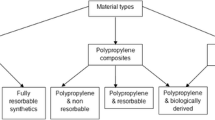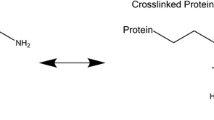Abstract
Introduction and hypothesis
The use of polypropylene meshes for surgical repair of pelvic organ prolapse (POP) has been limited by complications, including mesh exposure, encapsulation, and pain. Numerous products are available with a wide array of textile and structural properties. It is thought that complications may be related, in part, to mesh structural properties. However, few descriptions of these properties exists to directly compare products. The aim of this study was to determine the textile and structural properties of five commonly used prolapse mesh products using a ball-burst failure protocol.
Methods
Porosity, anisotropic index, and stiffness of Gynemesh PS (n = 8), the prototype polypropylene mesh for prolapse repair, was compared with four newer-generation mesh produces: UltraPro (n = 5), SmartMesh (n = 5), Novasilk (n = 5), and Polyform (n = 5).
Results
SmartMesh was found to be the most porous, at 78 % ± 1.4 %. This value decreased by 21 % for Gynemesh PS (p < 0.001), 14 % for UltraPro and Novasilk (p < 0.001), and 28 % for Polyform (p < 0.001). Based on the knit pattern, SmartMesh and Polyform were the only products considered to be geometrically isotropic, whereas all other meshes were anisotropic. Comparing the structural properties of these meshes, Gynemesh PS and Polyform were the stiffest: 60 % and 42 % stiffer than SmartMesh (p < 0.001) and Novasilk (p < 0.001), respectively. However, no significant differences were found between these two mesh products and UltraPro.
Conclusions
Porosity, anisotropy, and biomechanical behavior of these five commonly used polypropylene mesh products were significantly different. This study provides baseline data for future implantation studies of prolapse mesh products.



Similar content being viewed by others
References
Drutz HP, Alarab M (2006) Pelvic organ prolapse: demographics and future growth prospects. Int Urogynecol J Pelvic Floor Dysfunct 17(Suppl 7):S6–S9
Boyles SH, Weber AM, Meyn L (2003) Procedures for pelvic organ prolapse in the United States, 1979–1997. Am J Obstet Gynecol 188(1):108–15
Brown JS et al (2002) Pelvic organ prolapse surgery in the United States, 1997. Am J Obstet Gynecol 186(4):712–6
Feola AJ et al (2010) Parity negatively impacts vaginal mechanical properties and collagen structure in rhesus macaques. Am J Obstet Gynecol 203(6):595e1–8
Chermansky C, Winters J (2012) Complications of vaginal mesh surgery. Curr Opin Urol 22:287–291
FDA, Urogynecologic Surgical Mesh: Update on the Safety and Effectiveness of Transvaginal Placement for Pelvic Organ Prolapse, E. F.a.D. Administration, Editor 2011
Haylen BT et al (2010) An International Urogynecological Association (IUGA)/International Continence Society (ICS) joint report on the terminology for female pelvic floor dysfunction. Int Urogyn J 21(1):5–26
Fenner DE (2000) New surgical mesh. Clin Obstet Gynecol 43(3):650–8
FDA, Public Health Notification: Serious Complications Associated with Transvaginal Placement of Surgical Mesh in Repair of Pelvic Organ Prolapse and Stress Urinary Incontinence, E. F.a.D. Administration, Editor 2008
Cardozo L, Staskin D (ed) Textbook of female urology and urogynecology. 2nd Edition ed. Vol. 1. 2006, Informa Healthcare
Jones KA et al (2009) Tensile properties of commonly used prolapse meshes. Int Urogynecol J Pelvic Floor Dysfunct 20(7):847–53
Deffieux X et al (2007) Vaginal mesh erosion after transvaginal repair of cystocele using Gynemesh or Gynemesh-Soft in 138 women: a comparative study. Int Urogynecol J Pelvic Floor Dysfunct 18(1):73–9
Ozog Y et al (2011) Persistence of polypropylene mesh anisotropy after implantation: an experimental study. BJOG 118(10):1180–5
Cowin SC, Doty SB (2007) Tissue mechanics. Springer, New York
Dalstra M et al (1993) Mechanical and textural properties of pelvic trabecular bone. J Biomech 26(4–5):523–35
Shepherd JP et al (2012) Uniaxial biomechanical properties of seven different vaginally implanted meshes for pelvic organ prolapse. Intl Urogyn J 23(5):613–20
Krause H et al (2008) Biomechanical properties of raw meshes used in pelvic floor reconstruction. Int Urogyn J 19(12):1677–1681
Afonso JS et al (2009) Structural and thermal properties of polypropylene mesh used in treatment of stress urinary incontinence. Acta Bioeng Biomech 11(3):27–33
Acknowledgements
National Institutes of Health (NIH) Support R01 HD061811-01
Conflicts of Interest
None
Author information
Authors and Affiliations
Corresponding author
Rights and permissions
About this article
Cite this article
Feola, A., Barone, W., Moalli, P. et al. Characterizing the ex vivo textile and structural properties of synthetic prolapse mesh products. Int Urogynecol J 24, 559–564 (2013). https://doi.org/10.1007/s00192-012-1901-1
Received:
Accepted:
Published:
Issue Date:
DOI: https://doi.org/10.1007/s00192-012-1901-1




